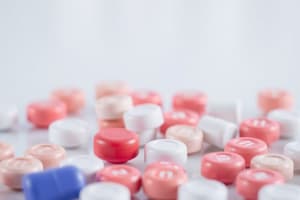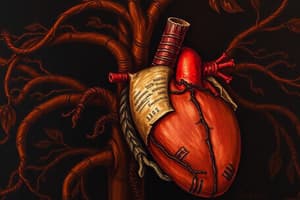Podcast
Questions and Answers
Which neurotransmitter is found at the neuromuscular junction of skeletal (only) muscles?
Which neurotransmitter is found at the neuromuscular junction of skeletal (only) muscles?
- Acetylcholine (correct)
- Nicotine
- Norepinephrine
- Muscarine
Which neurotransmitter is an agonist for Nicotinic receptors?
Which neurotransmitter is an agonist for Nicotinic receptors?
- Muscarine
- Nicotine (correct)
- Curare
- Norepinephrine
Which neurotransmitter is found at the neuromuscular junction of smooth and cardiac muscle?
Which neurotransmitter is found at the neuromuscular junction of smooth and cardiac muscle?
- Muscarine (correct)
- Acetylcholine
- Norepinephrine
- Nicotine
Which neurotransmitter is an antagonist for Muscarinic receptors?
Which neurotransmitter is an antagonist for Muscarinic receptors?
Which type of agent affects the conduction speed in the AV node and subsequently the rate of electrical impulses in the heart?
Which type of agent affects the conduction speed in the AV node and subsequently the rate of electrical impulses in the heart?
What is the primary effect of dopamine at low doses?
What is the primary effect of dopamine at low doses?
What is the net effect of dobutamine on the heart and blood vessels?
What is the net effect of dobutamine on the heart and blood vessels?
How can arterial pressure (blood pressure) be raised according to the text?
How can arterial pressure (blood pressure) be raised according to the text?
What is the main mechanism of action of tricyclic antidepressants?
What is the main mechanism of action of tricyclic antidepressants?
Which neurotransmitters are affected by MAOIs blocking monoamine oxidase?
Which neurotransmitters are affected by MAOIs blocking monoamine oxidase?
What is the main effect of Xanax (Benzodiazepine) on the body?
What is the main effect of Xanax (Benzodiazepine) on the body?
What are the main actions of Beta 2 adrenergic receptors when stimulated?
What are the main actions of Beta 2 adrenergic receptors when stimulated?
How does epinephrine primarily act on adrenergic receptors?
How does epinephrine primarily act on adrenergic receptors?
Which term refers to small molecules and ions that relay signals received by cell-surface receptors to effector proteins?
Which term refers to small molecules and ions that relay signals received by cell-surface receptors to effector proteins?
What does the blood-brain barrier control in terms of molecule passage?
What does the blood-brain barrier control in terms of molecule passage?
Which parameter is used to describe the activity of drugs in the body over a period of time?
Which parameter is used to describe the activity of drugs in the body over a period of time?
What does osmosis refer to?
What does osmosis refer to?
In pharmacokinetics, what does bioavailability indicate?
In pharmacokinetics, what does bioavailability indicate?
What is the term used to describe the loss of the difference in charge between the inside and outside of the plasma membrane of a muscle or nerve cell due to a change in permeability and migration of sodium ions to the interior?
What is the term used to describe the loss of the difference in charge between the inside and outside of the plasma membrane of a muscle or nerve cell due to a change in permeability and migration of sodium ions to the interior?
Where does the initiation of another action potential occur when neurotransmitters interact with receptor proteins on the membrane of the postsynaptic cell?
Where does the initiation of another action potential occur when neurotransmitters interact with receptor proteins on the membrane of the postsynaptic cell?
What is the term used for the space between the junction of two neurons in a neural pathway where the termination of the axon of one neuron comes into proximity with the cell body or dendrites of another?
What is the term used for the space between the junction of two neurons in a neural pathway where the termination of the axon of one neuron comes into proximity with the cell body or dendrites of another?
Which term refers to originating within the body?
Which term refers to originating within the body?
What is defined as a stage of an action potential in which the cell experiences a decrease of voltage due to the efflux of potassium ions along its electrochemical gradient?
What is defined as a stage of an action potential in which the cell experiences a decrease of voltage due to the efflux of potassium ions along its electrochemical gradient?
How does norepinephrine affect heart rate?
How does norepinephrine affect heart rate?
What effect does dopamine have on heart rate?
What effect does dopamine have on heart rate?
Which receptor type does dopamine NOT activate?
Which receptor type does dopamine NOT activate?
In terms of blood pressure, what effect does norepinephrine have?
In terms of blood pressure, what effect does norepinephrine have?
What distinguishes dopamine from other catecholamines in its effects on heart rhythm?
What distinguishes dopamine from other catecholamines in its effects on heart rhythm?
Which medication is used as an antidote for opioid overdose?
Which medication is used as an antidote for opioid overdose?
What can be a life-threatening side effect of administering pressors such as dopamine?
What can be a life-threatening side effect of administering pressors such as dopamine?
In the context of pharmacologic interventions, what is a potential complication of TCA overdose?
In the context of pharmacologic interventions, what is a potential complication of TCA overdose?
Which medication is commonly associated with causing hypokalemia in patients with renal failure or on dialysis?
Which medication is commonly associated with causing hypokalemia in patients with renal failure or on dialysis?
What is the primary use of atropine in the context of drug interventions?
What is the primary use of atropine in the context of drug interventions?
Which neurotransmitter is naturally occurring and acts on α, β1, and dopaminergic adrenergic receptors?
Which neurotransmitter is naturally occurring and acts on α, β1, and dopaminergic adrenergic receptors?
What is a potential grave consequence of statin use in some patients?
What is a potential grave consequence of statin use in some patients?
What symptom presentation is associated with extrapyramidal symptoms (EPS)?
What symptom presentation is associated with extrapyramidal symptoms (EPS)?
What is the appropriate treatment for insulin overdose?
What is the appropriate treatment for insulin overdose?
What is the primary use of naloxone in clinical practice?
What is the primary use of naloxone in clinical practice?
Flashcards are hidden until you start studying
Study Notes
Neurotransmitters and Receptors
- Acetylcholine is found at the neuromuscular junction of skeletal muscles.
- Acetylcholine is an agonist for Nicotinic receptors.
- Acetylcholine is also found at the neuromuscular junction of smooth and cardiac muscle.
- Muscarine is an antagonist for Muscarinic receptors.
Heart Regulation
- Parasympathetic stimulation affects the conduction speed in the AV node and subsequently the rate of electrical impulses in the heart.
- Dopamine has a primary effect of increasing renal blood flow at low doses.
- Dobutamine has a net effect of increasing contractility and heart rate, while decreasing systemic vascular resistance.
Blood Pressure and Vessels
- Arterial pressure (blood pressure) can be raised by increasing cardiac output, peripheral resistance, or both.
- Epinephrine primarily acts on alpha-1, alpha-2, beta-1, and beta-2 adrenergic receptors.
- Beta 2 adrenergic receptors, when stimulated, cause smooth muscle relaxation, increase insulin secretion, and increase glucagon secretion.
Pharmacology
- MAOIs (Monoamine Oxidase Inhibitors) block the breakdown of norepinephrine, serotonin, and dopamine.
- Tricyclic antidepressants work by increasing the levels of norepinephrine, serotonin, and dopamine in the synaptic cleft.
- Xanax (Benzodiazepine) has a main effect of enhancing the activity of GABA, an inhibitory neurotransmitter.
Cellular Signaling
- Second messengers are small molecules and ions that relay signals received by cell-surface receptors to effector proteins.
- The blood-brain barrier controls the passage of molecules into the brain.
- Pharmacokinetics describe the activity of drugs in the body over a period of time.
- Osmosis refers to the movement of water molecules from an area of high concentration to an area of low concentration.
Pharmacodynamics
- Bioavailability indicates the proportion of the administered dose that reaches the systemic circulation.
- Depolarization is the term used to describe the loss of the difference in charge between the inside and outside of the plasma membrane of a muscle or nerve cell.
- An action potential is initiated when neurotransmitters interact with receptor proteins on the membrane of the postsynaptic cell.
Other Key Concepts
- Endogenous refers to originating within the body.
- The repolarization phase is defined as a stage of an action potential in which the cell experiences a decrease of voltage due to the efflux of potassium ions along its electrochemical gradient.
- Norepinephrine increases heart rate, while dopamine has no effect on heart rate.
- Dopamine does not activate M5 receptors.
- Norepinephrine increases blood pressure.
- Dopamine has a unique effect on heart rhythm due to its effect on the SA node.
Clinical Pharmacology
- Naloxone is used as an antidote for opioid overdose.
- A life-threatening side effect of administering pressors such as dopamine is arrhythmias.
- A potential complication of TCA overdose is cardiac arrhythmias.
- Furosemide can cause hypokalemia in patients with renal failure or on dialysis.
- Atropine is used to increase heart rate in the context of drug interventions.
- Dobutamine is a naturally occurring neurotransmitter that acts on α, β1, and dopaminergic adrenergic receptors.
- A potential grave consequence of statin use in some patients is rhabdomyolysis.
- Extrapyramidal symptoms (EPS) are associated with symptoms such as dystonia, akathisia, and parkinsonism.
- The appropriate treatment for insulin overdose is administration of glucose.
- Naloxone is used to treat opioid overdose in clinical practice.
Studying That Suits You
Use AI to generate personalized quizzes and flashcards to suit your learning preferences.




